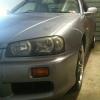Loose Muffler/exhaust
Announcements
-
Similar Content
-
Latest Posts
-
Yeah I like it, I haven't seen the others in person so can't compare but I'm happy with it
-
Any Q or V going to this event? SAU NSW x Benzin Cafe Cars & Coffee Sunday 12th October 2025 7:30AM Meeting Benzin Cafe Meet Location: Benzin Cafe Dural RSVP: https://forms.gle/Q9TcFu9DHe4dbvtKA
-
You've definitely taken out the "most images in a single post" record! This looks awesome, I'm loving it. Its funny how the OEM movement has come back around again, I love the OEM GTR wheels on this car with that colour!
-
Ha ha, I was over here researching if there's any KLine diagnostics out there, and the next step was going to be looking for the pinouts to work out what/how it's controlled.
-
@Yeetus Happy with the loop? Trying to decide loop or pile.
-








Recommended Posts
Create an account or sign in to comment
You need to be a member in order to leave a comment
Create an account
Sign up for a new account in our community. It's easy!
Register a new accountSign in
Already have an account? Sign in here.
Sign In Now